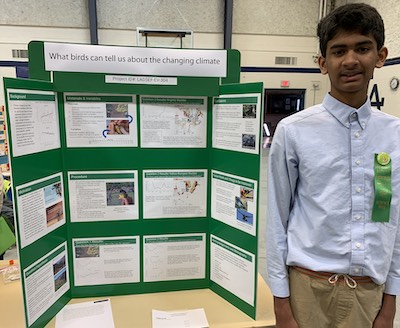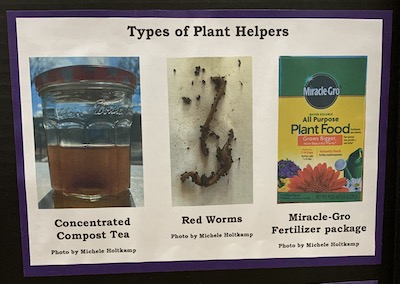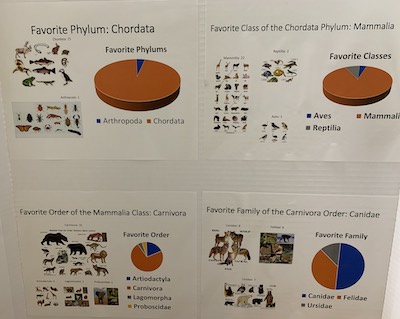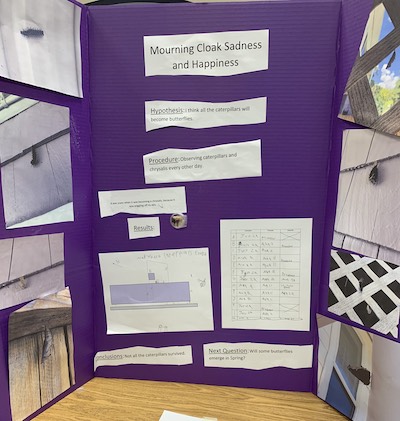By Jennifer Macke
The 2023 Los Alamos County science fair was held in person on January 20, 2023. Each year, PEEC provides small cash awards to students at the fair. In judging for these prizes, we look for projects that take inspiration from nature, particularly those that use local materials from nature, are conducted outdoors, or aim to improve and understand the environment.
Mapping Anthropogenic Ocean Litter with an Autonomous Underwater Vehicle


Daniel Kim, grade 11, Senior Division
This project sought to develop a tool for identifying submerged garbage in oceans. While surface trash can be detected by satellites, other approaches are needed to detect submerged materials. The student designed and built an underwater glider that could move through the water by changing its buoyancy. The project also included the development of software to log and display sensor data and control the glider.
Hummingbird Preferences


Aislinn Marshall, grade 8, Junior Division
The study was rooted in an observation the student made in her own yard; despite reports that hummingbirds prefer red flowers, she noticed that they also frequently visited flowers of other colors. The study tested hummingbird color preference by using nectar feeders of three different colors. The amount of food consumed from each feeder was measured by weighing the feeder. The student also became proficient at identifying local hummingbird species. The results revealed a slight preference for the red feeder versus the blue or purple feeder.
What Birds Can Tell Us About the Changing Climate


Aditya Viswanathan, grade 8, Junior Division
The project involved the analysis of 10 years of bird banding data taken at Bandelier National Monument to answer three questions. First, when birds repopulate an area after fire, do certain species return sooner? Second, are there some bird species that are increasing or decreasing at Bandelier? And third, is a decade of banding data sufficient to see meaningful trends? The answer to all three questions was basically yes. In particular, interesting trends were observed for Virginia’s Warbler and Yellow-rumped Warbler.
Mushroom Moisture Mystery


Jasper Stauffer, grade 6, Junior Division
In this project, the student tested the hypothesis that periods of greater rainfall would result in more mushrooms. He charted yearly rainfall and the amounts of edible mushroom species collected each year at the same sites. The results defied the hypothesis; years with greater rainfall didn’t always result in more mushrooms. In the two years with greater rainfall, the rain came in different months, and the student hypothesized that rain coming later in the year didn’t produce as many mushrooms due to the greater growth of other plants at that time.
Let It Grow


Sabastian Holtkamp, grade 5, Elementary Division
This study looked at “plant helpers” to identify additives that grow better plants. The purpose was “To give my dad tips for next year’s garden.” The helper substances studied were compost tea, worms, and commercial fertilizer. The results were nicely documented. Based on the results, compost tea was the winner.
What is Your Favorite Animal?


Claire Reardon, grade 4, Elementary Division
The purpose of the study was to assess what animals people prefer. The student surveyed other students, asking them to state their favorite animal. What stood out about this study was the student’s efforts in identifying the full species names of the animals and in charting the results based on animal classifications. Of particular merit, the Conclusion stated “How you look at your data makes a big difference.” While more students chose cats versus dogs, more chose members of the dog family versus the cat family.
Mourning Cloak Sadness and Happiness


Eleanor Nora Haaser, grade 2, Elementary Division
This study was strictly observational but was a nice beginning project for a second-grade student. The student collected butterfly chrysalises, observed their development, and documented how many hatched. Most scientists begin their careers by observing things in the natural world, and this student is off to a great start.

